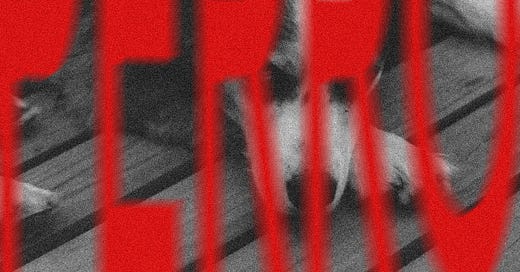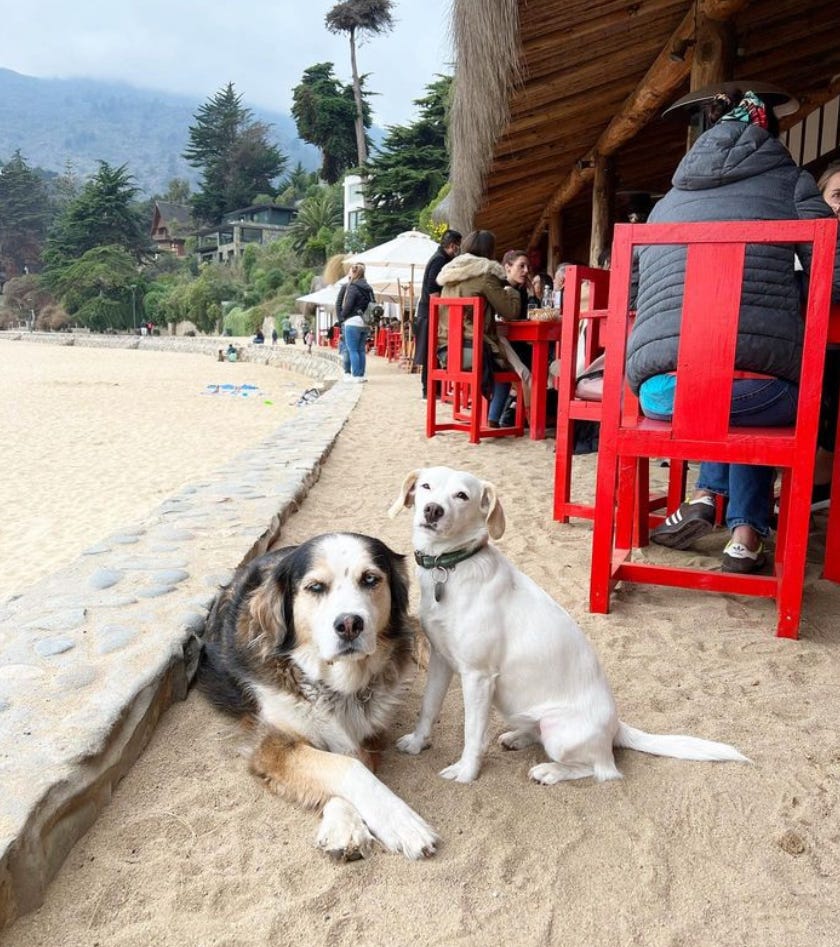Hi, I'm George Westcott. It was about a month ago when I got a text from my parents telling me that they were going to put down Bruno, my dog in Chile. I had grown up around this dog ever since it suddenly appeared on our family farm, another stray in the mix. He was this fluffy mid-sized quiltro with the brightest bluest eyes that you have ever seen. He was one of those dogs that would talk to you, barking or yowling back when I would speak to it. He was always a sad dog, possibly suffering from some level of doggy depression. Regardless of the weight he carried, he was a loyal companion and a great friend. Sleep easy, my blue-eyed boy.
His death has made me reflect more about the quiltro, the Chilean mixed breed I wrote about some months ago at this point. I've fixated so hard on said point you can say that I changed the name of this whole ship because of it. I stand to be corrected but I think about the lack of dogs in my life every time I walk out of the house, and it is strange. There's something so isolating about coming back home and being alone. I know that I may have complained in my personal life about life with housemates, my room leaking with water during the first month in Amsterdam. However, I found a lot of comfort in living with people who I could talk with. This has made me miss the life with dogs, the good life.
I have also been rereading Anzaldua, as I normally do, this time for the editing of my thesis publishing project that's happening (I know I've been hinting at it but our budget got approved). I have again fixated on the mestiza consciousness concept, a specific idea that has always been called out to me, like a siren to sailor. I find myself, unable to develop on top of it, seemingly a perfect fit to why I think that the quiltro is such a specific excellent match to my own cultural experience in Chile. I have written about it before on this blog.
What I essentially did was apply why I thought the quiltro was a better fit for the marker of Chilean identity through the lens of Anzaldua's work on "The Borderlands" (Anzaldúa, 1987). What I wanted to do with it is find a way of expanding on the concept in some way, proposing the Quiltro consciousness. It is of greatest dishonor to report that this was not done in the past essay. I was able to connect the mixed nature of the quiltro to the mestiza's mixed nature, I was able to connect the revolutionary spirit of the Chileans and the Quiltros to the social consciousness that comes inherent with mestiza consciousness. Even the survival element of both the mestiza and the quiltro are related with them both being in some sense deeply tied to survival strategies. EVEN further, their connection to nature and the "Tierra" as Anzaldua puts it, is also a link between mestizo and the dogs, them both being tied to the land they inhabit (Anzaldúa, 1987). A large group of the Quiltros are wild dogs and the mestizo has a connection to where they live, the space they inhabit. I could not, however, point towards the specific elements of the Quiltro that could expand on what Anzaldua has written about. A difficult task.
Thinking about Bruno however, is the fact that I loved this dog. I think everyone who knew this dog loved him, the singing, blue-eyed, Westcott quitro. These dogs have deep roles and spaces they occupy in our lives. May they be the loyal companions that pick us out or we pick up on our roads through life or the scrappy town dog that is communally taken care of by its people. They occupy space. The Anzaldua concept of the mestiza does not account for the fact that people with mestiza consciousness have a connection with their community in some way, only that they are culturally hybrid. (Anzaldúa, 1987)
While Anzaldua argues that Mestizas have an ambiguity of space, I think that they can claim, and theorize their own position around what they do through their communities. The ambiguity of role, of being culturally hybrid, still means that you are still connected with people, through love. I think that's what the quiltro offers in this sense. My dog was not only just a mixed breed, with an ambiguous role between wild street dog and house dog for a very long time but is still my friend, regardless of cultural makeup. I think that we can conceptually frame it. I think love is the answer though (cliche as it may sound). Whether they be companions or communal friends, the quiltro has a social gain in some way, a spiritual benefit to society. I think sometimes I feel like whenever I read about the mestiza, it is a lens to analyze the ills and ways of pushing activism further. Interjecting here, I think these valid points and I find them to be incredibly useful for activist and activism-centered activities. This point was made by Sylvanna Falcón in her research and theorizing around mestiza double consciousness in her book "MESTIZA DOUBLE CONSCIOUSNESS: The Voices of Afro-Peruvian Women on Gendered Racism." (Falcón, 2008)
What I would like to add to the discussion is how the quiltro, as a framing tool towards mixed identity, can help us understand the social value that we bring in being culturally hybrid. This is an optimistic expansion of Anzlaldua's work. The quiltro has intrinsic value to its community. The quiltro is a benefit to our space, to our community. Mixed identity is not purely to analyze our ills but instead a lens that can offer the positives we share in our community, like el Quiltro.
I want to wrap this up by attempting to put words on why I find such personal fulfillment in writing about Anzaldua and Chilean symbolism through el Quilro. I never felt fully represented in my community. It is possible that I was just a queer kid in a school that had completely different values to what I believed was what called out to me. I never felt a calling towards any identity that I could see in my daily life. There are very few children in Chile who were born there, lived there their whole lives, and speak better English than Spanish. I always felt like a full outsider in my community from my mixed upbringing. In some way, it was only until I started to connect with the artifact that my grandfather had left behind that I felt some semblance of belonging, of an identity. When I found Anzaldua, it was like a eureka moment. A writer who had hit the nail on the head of why I felt like I did, and how my mixed identity in Latin America functioned. I have a lot of admiration for her work, and the artifact she has left behind. I think this whole process of trying to find a lens for understanding mixed identity has been a deeply personal one. I have stakes in the race.
Sources:
Falcón, S. M. (2008). MESTIZA DOUBLE CONSCIOUSNESS: The Voices of Afro-Peruvian Women on Gendered Racism. Gender and Society, 22(5), 660–680. http://www.jstor.org/stable/27821682
Anzaldúa, G. (1987). Borderlands = la frontera : the new mestiza. San Francisco, Spinsters/Aunt Lute.








